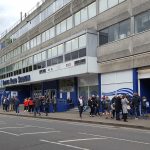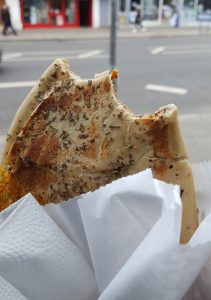Queens Park Rangers 0 Nottingham Forest 1
Championship
Saturday 27 April 2019
The context
I bought two publications outside Loftus Road that reminded me why I was keen to go there again – the London Socialist Party’s Reclaim the Game pamphlet, and issue 350 of Kick Up the R’s fanzine. Both were still going strong from earlier visits, maintaining the mix of rebellion and self-effacing humour that characterises this most unique of support bases.
QPR fans are an interesting mix of the edgy and the eccentric, a kind of Fulham with attitude. This is a traditional working-class area still holding out against the creeping gentrification of West London. The club’s DNA is the panache and charisma of Bowles, Marsh and Francis, meshing awkwardly with long years of mediocrity and farce and presenting a collective two fingers to the Establishment.
- alive…
- …and kicking
The history
This part of Middlesex was open fields until the Edwardian era, until in 1908 it was chosen as the venue for the Franco-British Exhibition, a public fair to celebrate the Entente Cordiale treaty between Britain and France. Events from that year’s Summer Olympics took place alongside the displays, and four major exhibitions were staged at the complex in the years leading up to World War One. White marble cladding was used to decorate the exhibition pavilions, and because of this the area became known as the Great White City.
- 1
- 2
- 3
- 4
1. The Great White City 2. The Great Stadium 3. Loftus Road in foreground, 1939 (Historic England) 4. 1966 and all that
The site also featured an Olympic stadium. This was called the Great Stadium and held 68,000 spectators. Predominantly a greyhound track from 1926 onwards, it also staged athletics and speedway as well as boxing, concerts, rugby, American football and the 1966 World Cup game between Uruguay and France. Rangers themselves played here for 3 seasons, between 1931-33 and 1962-63, in what proved abortive attempts to attract larger crowds than they could at Loftus Road. For a time it seemed every town wanted its own White City, and imitations sprang up in Cardiff, Glasgow, Manchester, Liverpool, Hull and elsewhere.
White City survives only as the name of the housing estate opposite the ground. The stadium was demolished in 1985 and the site used for a BBC studio. Nowadays it’s covered by new buildings, with the street that once ran past the turnstiles diverted into a cul-de-sac. In its last days this was a shabby place, starved of funds and supporting a dog-racing culture in terminal decline. Yet it had a faded glory, and it left a void in Shepherd’s Bush that has never been filled.

The Pogues commemorated it in 1989:
Oh sweet city of my dreams
Of speed and skill and schemes
Like Atlantis you just disappeared from view
And the hare upon the wire
Has been burnt upon your pyre
Like the black dog that once raced out from trap two.
The journey
We followed the M40 to Western Avenue and parked at West Ruislip. From here it was a mere 20 minute hop on the District Line to White City, itself just 5 minutes from the ground. QPR is well-served by the Underground, with Wood Lane (on the Circle and City & Hammersmith lines) a few yards down the same road, opposite BBC Television Centre.
The redevelopment of this complex into yuppie flats with their attendant coffee bars, gyms and other tarty paraphernalia has changed the dynamic of Shepherd’s Bush. Where once there was bustle, now there’s urban chic. You won’t now bump into TV stars on your way to a Rangers match. The walk feels a lot less edgy. No longer is Loftus Road the most filmed ground on TV, and no longer is the address for Blue Peter “Wood Lane, London.”
For many years there was an abandoned Tube station on Wood Lane. This had been the original Wood Lane station, on the District Line. Built in 1908 to serve the Franco-British Exhibition, it was decommissioned in 1947 when the present-day White City station replaced it. This corner of London is something of a Mecca for ghost station hunters. For those who like that kind of thing, it’s very well explained here:
The ground
Loftus Road is encased by streets and houses like a hard-boiled egg in its shell. The 1968 main stand on South Africa Road is the only structure you can get near to from the outside, and is therefore the most photographed part of the ground. The narrowness of the road, its curve and the amount of wheeled and pedestrian traffic trundling past make it an awkward subject. The School End is totally hemmed in by – well, a school. And entry to the Loftus Road and Ellerslie Road stands is via narrow openings between houses, whose rear gardens back directly onto the concourses.
- most photographed
- hemmed in
- between houses
Rangers bought 39 neighbouring houses as an investment following the Third Division title win in 1948. They were soon sold to raise funds, but the history of the ground might have been very different, and its present day character far less cramped, had the club been able to use the land for expansion. As it is the Batman Close flats complete a concrete straitjacket, meaning that the only way to see the whole of Loftus Road’s exterior is from the air.
Batman Close was regrettably named after John Batman, the founder of Melbourne, rather than the Caped Crusader. The rather grim pub at its entrance – a gauntlet to and from from the tube run by many an away fan – was for many years called the Springbok, but is now the far duller Queens. Commonwealth street names abound in the area, round the corner on Bloemfontein Road and in the pre-War White City Estate (also a place once worth avoiding). These exotic titles were chosen to celebrate the Franco-British exhibition, which featured a strong Colonial theme.
A new Ellerslie Road Stand went up in 1972, replacing one that originally stood at Rangers’ pre-1917 home in Park Royal (this stadium occupied the site of the now-demolished Guinness brewery, held 60,000 and was an exact replica of Middlesbrough’s Ayresome Park). The two terraced ends, meanwhile, were improved and had upper seating tiers added in 1980 (the School End) and 1981 (the Loft). This meant the whole ground had been transformed in just over a decade.
At the same time QPR installed a “plastic” pitch. The artificial surface was in place for seven seasons, during which time it proved almost universally unpopular with every visiting player who attempted to control a ball on it. Goalkeepers in particular found it hard work, and were obliged to wear tracksuit bottoms to avoid carpet burns. On the plus side, postponements were rare and TV viewers were treated to the sight of horse shit being swept up with brooms during a lively Cup-tie against West Ham. And its appearance coincided with the team reaching two finals and winning the Second Division championship, a synchronicity about which Rangers fans are still justifiably defensive.
Loft regulars mourned the loss of their popular end with its dark and moody 1938 roof. But the 1981 remodelling was timely, and resulted in the ground you see today. The compact and modern Loftus Road proved relatively easy to convert to seating – albeit at the cost of some bad sightlines, and even worse legroom.
Flesh and wine
Uxbridge Road is takeaway heaven. From Shepherd’s Bush Green for a good mile towards Acton, you’re not likely to either go hungry or be far out of pocket. The choice wasn’t what to eat, rather what not to eat. But once I’d clocked a Lebanese pie shop with its window full of savoury pastries the size of oven gloves, the decision was made. Mushroom is “fatar” in Arabic, and lamb is “hamal”. So there you go.
Drinking was slightly more tricky. There are pubs a-plenty, but a distressing number are rebranding themselves as “contemporary”, “gastro”, “retro” and the like. Some even claim to be “old school” (they aren’t). So we were very pleased indeed with the Coningham Arms, a raucous, rammed yet friendly boozer with a decent mix of ages, sexes and the flat caps beloved of fans in the capital. A patch of red near the side door betrayed a clutch of Forest fans minding their own business, and a door policy that looked not at the scarf but the person wearing it.
John took no chances after his ordeal at Craven Cottage, and pounced on a burger van by the football pitches on South Africa Road. It was by then nearing kick-off, so we swerved a gaggle of pissed-up fifty-something Forest lads on some sort of reunion (Stone Island meets Eamonn Andrews) and smuggled John’s chips through the turnstiles, where I grabbed a Pukka pie on the concourse to stave off the pangs until half time.
The game
No one, including the players, took matters on the pitch too seriously. Managerless QPR were seeing out a dismal season and Forest had blown the play-offs, so a decent crowd and a full away end had little to do save party (Forest fans) and grumble (the rest).
Once more we found ourselves on the back row, towards the Loft corner of the upper part of the South Africa Road stand. This area was sparsely populated and most people seemed to know/be related to each other, so a jocular atmosphere prevailed. As an added bonus you could stand, if the knee-crunching lack of legroom was a problem – which indeed it would be for anyone not having the height or body mass of a pygmy.
A slight frisson of interest was generated by Des Walker’s son Lewis turning out for Rangers, but it vanished when he failed to impress and was subbed soon after half time. The home team played lots of nice football but were dreadful in front of goal, a shortcoming demonstrated on 88 minutes when Nahki Wells directed a harsh penalty straight at Pantalimon. Forest had a bit more verve about them – the game’s only goal was a swashbuckling affair, Ansarifard latching onto an astute pass from Carvalho before bursting between two defenders and smacking the ball past Lumley.
Teams and goals
QPR: Lumley, Furlong, Leistner, Cameron, Manning, Eze (Wells 75), Luongi, Scowen, Osayi-Samuel, Hemed (Smith 75), Walker (Shodipo 59). Unused subs: Ingram, Freeman, Wszolek, Carlyle.
Forest: Pantilimon, Wague, Milosevic, Robinson, Byram, Yates, Cash (Yacob 82), Osborn, Lolley, Antunes Carvalho (Guediora 82), Ansarifard (Grabban 64). Unused subs: Watson, Murphy, Steele, Appiah.
Goal: Ansarifard 55.
Attendance: 15,212.























